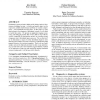29 search results - page 5 / 6 » Inductive trace properties for computational security |
NETGAMES
2006
ACM
13 years 11 months ago
2006
ACM
While psychologists analyze network game-playing behavior in terms of players’ social interaction and experience, understanding user behavior is equally important to network res...
POPL
2006
ACM
14 years 5 months ago
2006
ACM
Noninterference is the basic semantical condition used to account for confidentiality and integrity-related properties in programming languages. There appears to be an at least im...
PERVASIVE
2008
Springer
13 years 5 months ago
2008
Springer
Opportunistic sensing allows applications to "task" mobile devices to measure context in a target region. For example, one could leverage sensorequipped vehicles to measu...
EUROSYS
2006
ACM
14 years 2 months ago
2006
ACM
Distributed systems are hard to build, profile, debug, and test. Monitoring a distributed system – to detect and analyze bugs, test for regressions, identify fault-tolerance pr...
ASIACRYPT
2003
Springer
13 years 10 months ago
2003
Springer
In this paper1 we propose a new symmetric block cipher with the following paradoxical traceability properties: it is computationally easy to derive many equivalent secret keys prov...

